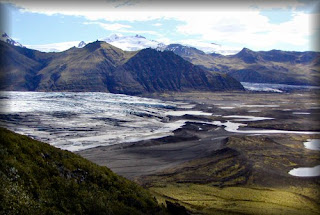As promised, I'm going to write today about the evolution of landscapes from glacial maximum through to interglacial. I'm particularly excited about this one because I find it really interesting. As I said in the last post, landscapes just go crazy. This post is primarily based on a leviathan of a review paper by Colin Ballantyne (2002) on paraglacial geomorphology, or the geomorphology of landscapes following ice retreat/ deglaciation.
Again, we will work with our hypothetical landscape as mentioned in the previous post. Imagine a glacier flowing down a glacial trough it has carved for itself. As air temperatures warm, the ice begins to retreat back up the valley.
The first effect is the lack of support for the valley walls as the ice buttressing the wall is now gone. This exposes a slope that is steeper than would have naturally formed in the absence of ice. This can result in catastrophic failures of slopes or a set of discrete rockfalls to bring the slope into equilibrium with the conditions it now finds itself in. These deposits are then weathered and reworked by periglacial processes, aeolian transport and slope drainage. It is common to find gullies and debris cones superimposed upon the classic glacial trough valley walls.
An increase in meltwater from a retreating glacier will result in enhanced glacio-fluvial reworking of glacial sediments and valley floors are often in-filled with a mix of glacial till and sediments derived from the paraglacial acceleration of hillslope modification processes.
Sediment yields for such areas are thought to follow something similar to an exponential curve, with glacial and paraglacial sediments being transported by fluvial activity at a much higher rate directly following deglaciation and a gradual trend towards "background" denudation rates as the landscape tends towards equilibrium with present conditions.
Proglacial lakes - in direct contact with the glacier front - make the transition to distal lakes as the glaicer retreats away from them. The characteristics of sedimentation also change as the glacier front retreats and eventually disappears. Initially sedimentation is primarily glacigenic deposits, exhibiting features such as ice contact deltas, sub-aqueous fans and moraines, submerged ice ramps from mass movement and rythmic laminated deposits. As the glaicer retreats the pro-gradation of gently sloping deltas occurs, with the rythmic deposition of sand, silt and clay. As mentioned earlier, sediment influx decreases over time as the glacier disappears completely.
Landscape adjustment towards an equilibrium position has been estimated to take up to 25,000 years. This implies that previously glaciated landscapes during the Last Glacial Maximum c. 12,000 years ago are still in the process of rebounding to non-glacial conditions. The implications of this should not be underestimated for sediment budget calculations in populated areas downstream of relict glacial environments.
Tomorrow I hope to introduce the ice core records and their validity as an indicator of solar insolation, so don't miss that one! I find it really interesting because it is important for both reconstructing past climates through the past 800,000 years and for attempting to model future climatic changes and our place within the global system. As I said, don't miss it!












